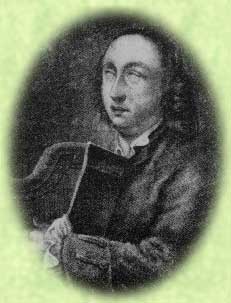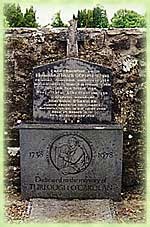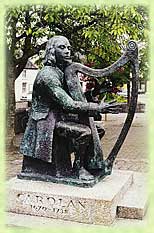

Biography
Perhaps no figure in the history of Irish music is more beloved than the harper-composer Turlough O’Carolan (1670–1738). A plaque in St. Patrick’s Cathedral in Dublin honors him as “the last of the Irish bards,” the man who brought to a close the centuries-old tradition of the wandering poet minstrel. The beautiful tunes he wrote can be found in the repertories of virtually every major Celtic band, and a section of “O’Niell’s Music of Ireland,” the Bible of Irish music, is entirely devoted to his compositions.
 From a protrait in the National Gallery of Ireland Painted from Life. Artist Unknown. |
 Carolan's grave site in Kilronan Churchyard outside of Keadue, Co Roscommon |
|---|
Carolan, The Man
Born in Nobber, County Meath in 1670 Carolan was the son of a local blacksmith. In childhood Carolan’s family moved to Ballyfarnon located on the Sligo, Roscommon border, where his father then worked for the McDermott Roe family, owners of the local iron works. The McDermott Roe family was to play a major role in Carolan’s life. Mary McDermott Roe saw to Carolan’s education as a child, and when he became blind at the age of 18 from smallpox, arranged for Carolan to be placed under the apprenticeship of a local Harper. After three years of training, Carolan was given money and a horse and sent on his way to earn his living.
Carolan married Ms. Mary Maguire of County Fermanagh in 1720, following a succession of affairs, recorded in the songs he wrote for his lovers. He settled his wife on a farm near Mohill, County Leitrim, where they had seven children, six daughters and a son. His wife died in 1733 and he is said to have never fully recovered from the bereavement.
He returned to the home of his friend and patron, Mrs McDermott Roe, where he died on the 25th March 1738 in his sixty-eighth year. Shortly before his death he called for his harp and with feeble fingers composed his final piece, the sorrowful “Carolan’s Farewell to Music”. By all accounts Carolan’s funeral was a memorable event. The wake lasted four days and was attended by lords, clergymen, gentlemen and a vast number of country people—all assembled to pay their respects to their favorite bard. Carolan was buried in the east end of the old church of Kilronan adjoining the vault of the McDermott Roe family.
Carolan, The Music
Carolan supported himself by providing harp lessons, but mostly by playing numerous tunes, which he composed in honor of his hosts and patrons. It was during his travels that he composed all of the 214 airs that have immortalized his fame, including the ever popular “Sheebeg and Sheemore.” American readers will be interested to know that “The Star Spangled Banner” is based on music composed by Carolan. Carolan was also known for his wit, love of drink, and for his appreciation of convivial hospitality. He was clearly popular with the society of the day, insofar as his notoriety spread even to the city of Dublin.
It was whilst moving amongst Dublin Society that Carolan heard Italian Baroque music, which was starting to become popular with the aristocracy as the country became Anglicized. Carolan admired the new music and sought to emulate it in many of his tunes. It was these influences, mixed with the Celtic tradition, which give Carolan’s music its unique flavor different from that of his predecessors.
The Music Lives On -Tara Gleeson,Glenn Weiser |
 Carolan statue in Mohill, County Leitrim where he lived most of his life |
|---|